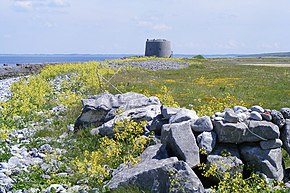Doorus Peninsula
| Doorus Peninsula | ||
 Aughinish Tower |
||
| Geographical location | ||
|
|
||
| Coordinates | 53 ° 9 '59 " N , 9 ° 0' 59" W | |
| Waters 1 | Galway Bay ( Atlantic Ocean ) | |
The Doorus Peninsula ( Irish : Dúros ) is located a few kilometers northeast of the Burren in County Galway in Ireland on the south bank of Galway Bay . It is named after the small town of Doorus, with an overgrown church ruin (Old Doorus church) at the beginning of the peninsula.
At the tip of the peninsula, on an island accessible via a dam, is the place Aughinish (also Aughnish, Irish Eachinis ). The former island of the same name belongs to County Clare and did not come to County Galway despite the (extremely narrow) connecting dam. The area was originally connected to the mainland but became the island in 1755 in the context of a tsunami effect from the massive Portuguese earthquake.
There are numerous monuments of Irish history on the peninsula. This includes
- two tidal mills,
- two holy springs ,
- a Martello Tower (Rine Martello Tower from 1804 - pictured)
- a mass rock (altar stone from the time of the Penal Laws )
- two wedge tombs .
The Doorus Peninsula was the home of members of the Lynch and Ffrench families , a tribe of Galway , in the 18th century .
Doorus
The place Doorus or Dúros (Irish: Dubh-Ros - black cape ) is in the north of today's hamlet between the beach and the pier of Parkmore. At the dam and the bridge that cut a small inlet there is a destroyed two-story windmill . The dam was built in the 19th century by the "de Basterot" family, which is important for the peninsula, as a compensation basin to control flooding.
The tide mills
Only the walls of the tide mills at Kinturley remain. The inscription B. B. on one probably refers to Bartholomew de Basterot (1800-1887), who later owned the mill built by Jacques de Basterot in 1804 and operated until the 20th century. It seems to have been a lime mill . Further east in Corranroe Bay are the ruins of another mill. The long, shallow inlet on the south coast of the peninsula makes this type of mill operation ideal.
The Irish Movement
In the 18th century the peninsula was owned by the Galway families Lynch and French . Frances French married the French nobleman Barthelemy, Comte de Basterot. She died young and after the French Revolution , the Comte claimed the inheritance. In 1866, Florimond de Basterot (1835–1904) built the Doorus House property (now the Bru an Óige Dúros youth hostel ). This was the Florimond who, with the help of his wealthy cousin Edward Martyn from Tullira, who was in turn a cousin of George Augustus Moore (1852-1933), played an important role in the literary movement at the beginning of the 20th century. In Doorus House Florimond accommodated guests such as Guy de Maupassant (1850-1893), Maurice Barrès (1862-1923), Paul Bourget (1852-1935). William Butler Yeats (1865-1939) and Lady Gregory (1852-1932) were frequent summer visitors. This is where the idea of the Irish Literary Theater (National Theater) was born in 1898 .
Wedge tombs
Wedge Tombs (German: " Wedge Graves", formerly also called "wedge-shaped gallery grave") are aisle-less, mostly undivided megalithic buildings from the late Neolithic and early Bronze Age . Doorus Demesne is an exceptional example of a wedge grave. The megalithic complex was placed under protection.
Aughinish Wedge Tomb (also called Leaba Dhiarmuid) on Galway Bay is less impressive but is mentioned as Dubhross in the legends recorded by Lady Gregorie .
The Martello Tower
The Rine Martello Tower on Aughinish is one of many similar relics in the British Isles that were erected in anticipation of a Napoleonic invasion of Ireland. Two of these towers were built on Galway Bay, one here and the other on the mainland at nearby Finvarra. The towers were built around 1804 and were manned by a garrison of ten to twelve soldiers. These oval structures are different from the round ones in the rest of the country. Its narrow side faces the sea. Today the tower is privately owned. At Parkmore, south of Finvarra, there is a memorial that commemorates Donnchadh Mór Ó Dálaigh , one of Ireland's greatest poets . His house and a Bavarian school, which he chaired, are said to have stood here.
A bulwark was built on the coast, presumably against the elements, of which a limestone wall has been preserved. A nearby menhir is said to have served as a signal for seafaring.
Newtownlynch
Four kilometers from the center of the island is the village of Newtownlynch. The area was owned by Lynch, who gave it their name. Mark Lynch built the chapel, which was illegal for school classes during the 1820s. So-called hedge schools followed. One of the secret places that operated until 1852 when the first proper school was built is in the east of the island. The particularly high level of illiteracy in Western Ireland of 85% fell to 22% between 1841 and 1901. Another facility associated with the Lynch's is Careolochan Pier, which was completed in 1823. Lynch had it built to use the faster sea route to his Galway store. However, the anchorage soon became muddy.
literature
- Thomas Johnson Westropp: Archeology of the Burren 1999 ISBN 1900545101 .
- Rose Glynn: The Story of Aughinish 2002.
Web links
- Doorus Wedge tomb pictures
- Martello Tower , description and picture
- Martello Tower
